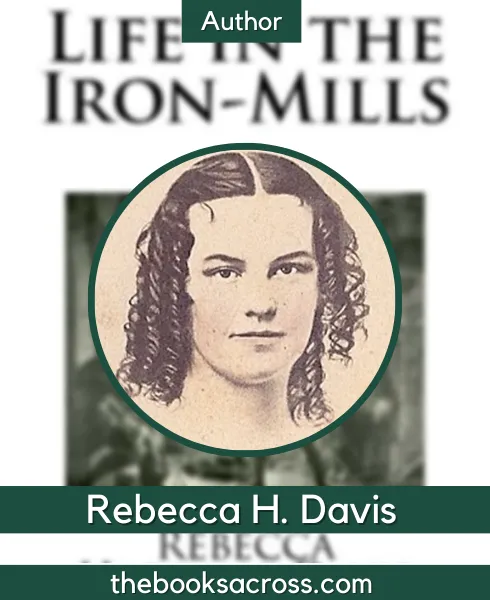Life in the Iron Mills PDF is a novella written by Rebecca Harding Davis, which was published in The Atlantic Monthly in April 1861. The story is set in an iron mill town in Virginia during the 19th century and follows the life of Hugh Wolfe, a Welsh worker in the mills, and his cousin Deborah, a woman with artistic aspirations. The novella was one of the first works of American literature to focus on the harsh realities of industrial life, and it has been widely regarded as a groundbreaking work in the literary canon.
The novella was published by James R. Osgood and Company in book form in 1861, and has since been reprinted numerous times. It has received critical acclaim for its vivid portrayal of the working-class experience and its exploration of social inequality, poverty, and the struggle for artistic expression in a world dominated by industry.
The book has been praised for its powerful themes, including the dehumanizing effects of industrialization, the destructive nature of capitalism, and the possibility of redemption through art and creativity. It has been compared to the work of other influential writers of the era, such as Charles Dickens and Walt Whitman, and has been credited with helping to inspire the American realism movement in literature. Life in the Iron Mills is available in a variety of formats, including print, ebook, and audiobook.
Table of Contents
Life in the Iron Mills Summary
It is a story that takes place in an industrial town in Virginia during the 19th century. The main character, Hugh Wolfe, is a Welsh worker in the iron mills who dreams of a better life. He is described as being physically strong but uneducated and poor.
Hugh’s cousin Deborah is a gifted artist who dreams of creating beautiful sculptures, but she is trapped in a life of poverty and has no way to pursue her artistic passions. She feels stifled by the bleakness of the industrial world around her.
The story begins with Hugh working in the mills and dreaming of a better life. He discovers a clay figurine created by Deborah and is inspired by her artistic talent. Hugh decides to steal some of the iron from the mill to create a mold for Deborah’s sculptures, hoping to help her realize her artistic potential.
However, things do not go according to plan. Hugh is caught stealing the iron and is sentenced to jail. Deborah is devastated by the loss of her cousin and her artistic dreams. She becomes ill and eventually dies. The story ends with a twist: the narrator reveals that the story was actually written by the prison warden, who found the manuscript in Hugh’s cell.
Details of Life in the Iron Mills Book
| Book | Life in the Iron Mills |
| Author | Rebecca Harding Davis |
| Original language | English |
| Originally published | April 1861 |
| Category | Realism |
| Publisher | The Atlantic Monthly |
| Total Pages | 42 |
| Format | PDF, ePub |
Life in the Iron Mills PDF Free Download
Click on the download button below to get a pdf file of Life in the Iron Mills book.
Multiple Languages Editions of Life in the Iron Mills Book
Life in the Iron Mills by Rebecca Harding Davis is available in English language editions, as it was originally written and published in English. There are no known translations of the novella into other languages.
| Book Editions | Check Now |
|---|---|
| English | Check Price |
About the Author
Rebecca Harding Davis was an American author and journalist who lived from 1831 to 1910. She was born in Pennsylvania and grew up in a family of prominent abolitionists and social reformers. Davis began her writing career as a journalist, working for newspapers in Pittsburgh and Philadelphia.

In 1861, Davis published her most famous work, Life in the Iron Mills, in The Atlantic Monthly. The novella received critical acclaim for its realistic portrayal of working-class life and its exploration of social inequality and the human condition. Davis continued to write throughout her life, publishing several other works of fiction and non-fiction.
Davis was also a pioneering female journalist who wrote about social issues such as poverty, women’s rights, and the plight of the working class. She was a frequent contributor to Harper’s Weekly and other publications, and her journalism helped to bring attention to important social issues of her time.
Overall, Davis is widely regarded as an important figure in American literature and journalism. Her writing has been praised for its realistic and compassionate portrayal of working-class life and its exploration of important social issues.
Similar Books to Life in the Iron Mills Book
- The Jungle by Upton Sinclair
- Germinal by Emile Zola
- Hard Times by Charles Dickens
- The Grapes of Wrath by John Steinbeck
- North and South by Elizabeth Gaskell
- Ragged Dick by Horatio Alger
- An American Tragedy by Theodore Dreiser
- Sister Carrie by Theodore Dreiser
FAQs(Frequently Asked Questions)
What is the main point of Life in the Iron Mills?
The main point of Life in the Iron Mills is to explore the struggles and hardships of the working class in the 19th century and the human condition in the face of industrialization and poverty.
Is Life in the Iron Mills a feminist work?
While Life in the Iron Mills does feature female characters and explores themes of gender inequality, it is not necessarily considered a feminist work.
How many pages is Life in the Iron Mills?
The length of Life in the Iron Mills can vary depending on the edition, but it is generally a short novella of around 50-60 pages.
What is the significance of the Korl woman in Life in the Iron Mills?
The Korl woman in Life in the Iron Mills represents the struggle for humanity and the possibility of finding redemption and beauty in the midst of harsh and dehumanizing conditions.
Who is the narrator of Life in the Iron Mills?
The narrator of Life in the Iron Mills is initially unknown, but it is later revealed to be the prison warden who discovered the manuscript in Hugh’s cell.







